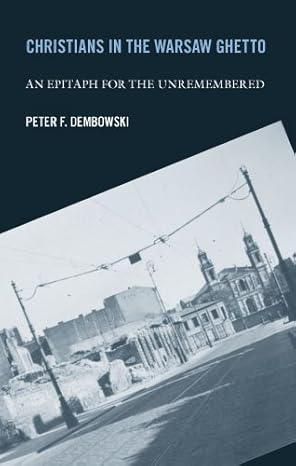| Title: | Christians in the Warsaw Ghetto - An Epitaph for the Unremembered |
| Writer: | Dembowski, Peter F. |
| Published: | University of Notre Dame Press |
| Published in: | 2005 |
| Pages: | 161 |
| ISBN: | 9780268025731 |
| Review: | Peter Dembowski’s reason for writing Christians in the Warsaw Ghetto is in the subtitle – An Epitaph for the Unremembered. He focuses on written materials about a setting he personally experienced: he was briefly in the Warsaw Ghetto as a teenage Christian who worked in the Polish resistance. He survived by luck and his intelligence, which included attentive, thoughtful observation. After a brief history of the Warsaw Ghetto, Dembowski describes the role of the churches which were included when the ghetto was walled off. In addition to offering spiritual counsel, the main roles these churches played included providing limited shelter, food, and medical treatment for Christians. Less well-known is that church members helped converts and others by providing false documents and other support that allowed them to leave the ghetto and survive. From materials written by people who were in the ghetto, Dembowski reports on 13 Jewish writers’ comments about the Christians in their midst and reports on five Christians’ comments about their own situation. His sources – written in the ghetto or afterwards – include diaries, journals, letters, memoirs, autobiographies, and notes. The writers give varying levels of detail about their lives and thoughts. Dembowski describes Jewish people who converted to Christianity as a distinct minority that faced “double estrangement”: they were separated from Christians outside the ghetto and rejected by Jews inside. He notes that all the terms commonly used in the writers’ languages for the Jewish-heritage people who chose Christianity were pejorative: converts, assimilated (into the non-Jewish culture), and assimilationist (also trying to convert others to Christianity). He discusses the antisemitism among non-Jewish Christian writers towards converts. He tackles the issue of the stereotyped assumptions among Jewish writers regarding the reasons for conversion, which could have been for survival, for faith, or for other reasons. Dembowski observes that antipathy is generally common towards anyone who has left any group – they “left us” and “joined them.” He concludes that each conversion carries its own story, with stereotyping inappropriate. He adds that stereotyping of Jews in general and Christian Jews in particular continued through decades of post-war communism in Poland. Dembowski notes that because of the changing situation in Warsaw and the growing realization of the Nazis’ intent, the period when a person wrote greatly affected the content, including the softening of attitudes towards Jews and converts. Finally, he writes that many Jews and Christian Jews were persecuted together and died together, adding that he authored this book because “They should be remembered together.” CommentsThe organization of Christians in the Warsaw Ghetto flows smoothly along the general lines of an academic paper: purpose, methods, findings, and conclusions. The list of Terms and Acronyms was important to this reader who knows no Polish.Dembowski relies on and includes excerpts from first-person accounts written in the ghetto and written in various locations and times after the war. He uses direct quotations frequently. The few original writings that survived are mainly in Polish and Yiddish, and some translations from Yiddish to Polish were of poor quality, sometimes due to a translator’s slanting the work towards acceptability in post-war Communist Poland. Fortunately, Dembowski knows Polish and carefully offers his observations (such as differences in translators’ word choices) and includes a long, annotated bibliography. By writing In English about the contents of these sources, he has met an objective of his: he made the sources and the forgotten Christians in the ghetto accessible to a much wider audience. At first, I skimmed the chapters describing the writings and hurried to Dembowski’s conclusions. After getting the big picture, I was glad to spend more time with what the writers said and with Dembowski’s thoughtful reflections on each. He points out with regret how few first-person documents there are that mention Christians in the Warsaw Ghetto. Nevertheless, these documents are what we have, and they are important. By including the words of people who were there, he allows us to see the nearly impossible challenges of surviving the ghetto and further of being a Christian there. Peter Dembowski’s Christians in the Warsaw Ghetto reminds us that among the millions murdered by the Nazis there was a minority group of Christians who were sent to the ghetto and then to death camps because they had some Jewish ancestry or because they chose to stay with the people closest to them. Christianity by itself did not protect against Nazi antisemitism and brutal murder. In contrasting the general Warsaw Ghetto conditions and the temporarily slightly better church-supported conditions there, the author makes more evident the desperation of all ghetto dwellers. Dembowski’s book also clearly describes the challenges of finding and translating memoirs and other documents. We are fortunate that he, a survivor with his own painful memories, took on this task of researching and then sharing in English the documented stories of an unremembered minority. |
| Rating: |      Excellent Excellent |
Information
- Article by:
- Anne Palmer
- Published on:
- 27-08-2025
- Feedback?
- Send it!
Images


